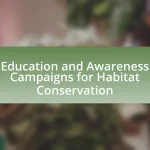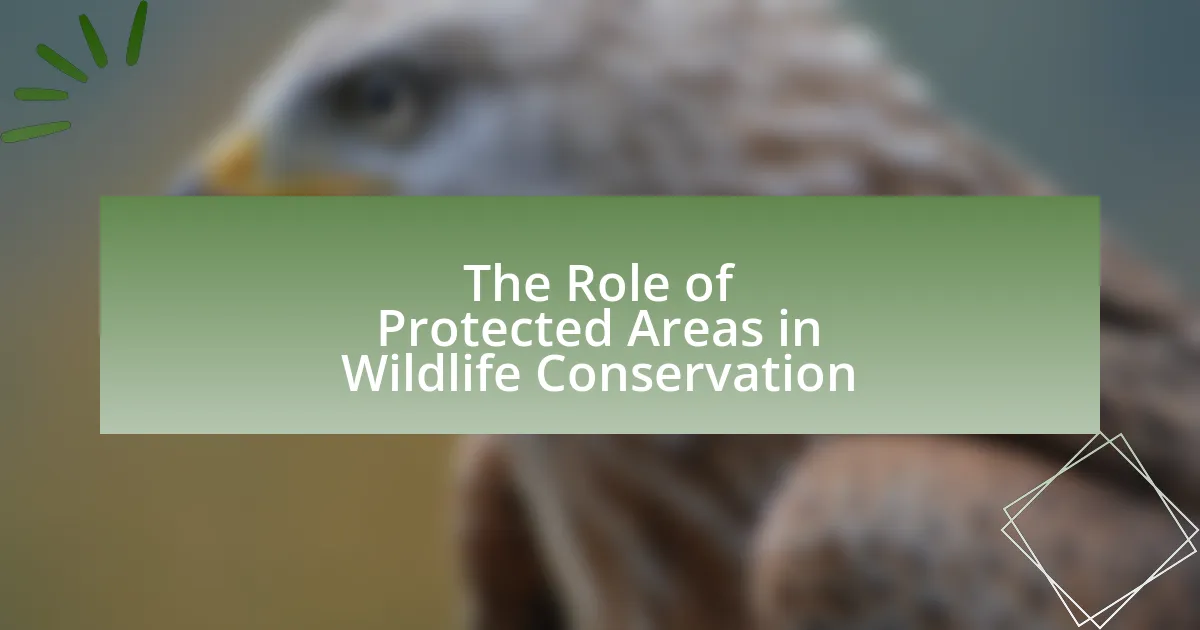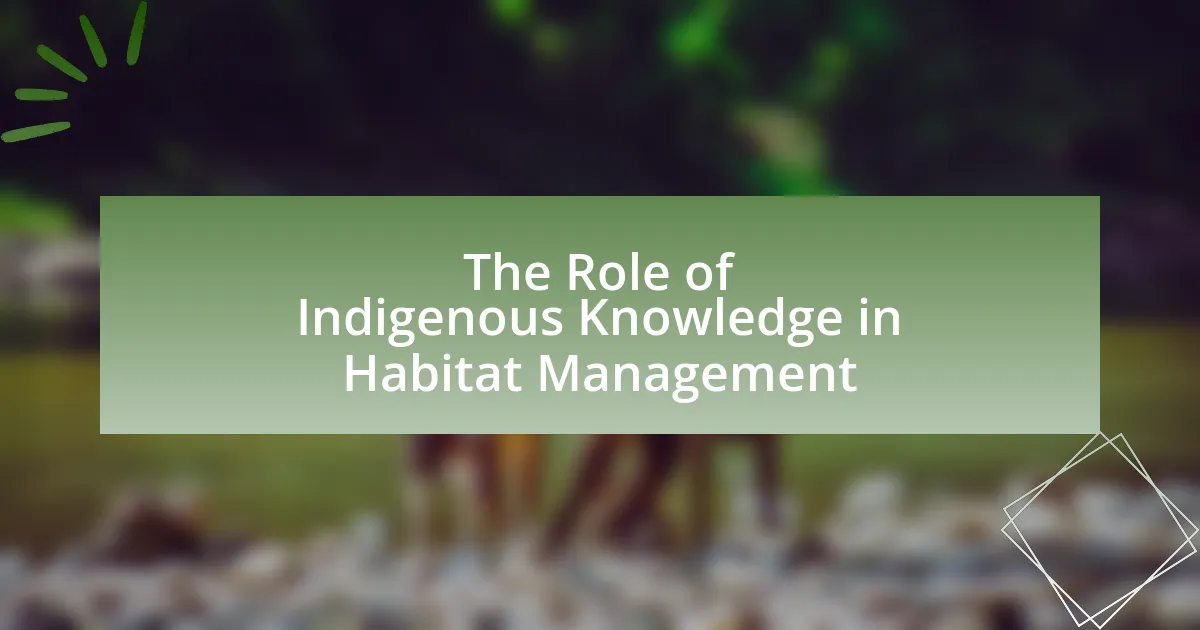Urban development significantly impacts local wildlife habitats by causing habitat loss, fragmentation, and pollution, which threaten biodiversity and ecosystem health. As cities expand, natural landscapes are altered, leading to a decline in species richness and disrupting predator-prey relationships. Specific wildlife species, such as the Eastern Box Turtle and American Robin, face heightened risks due to these changes. Strategies to mitigate these impacts include creating wildlife corridors, implementing green infrastructure, and engaging community initiatives, all of which can enhance biodiversity and support conservation efforts in urban settings. Understanding these dynamics is crucial for informed urban planning that balances development with wildlife protection.
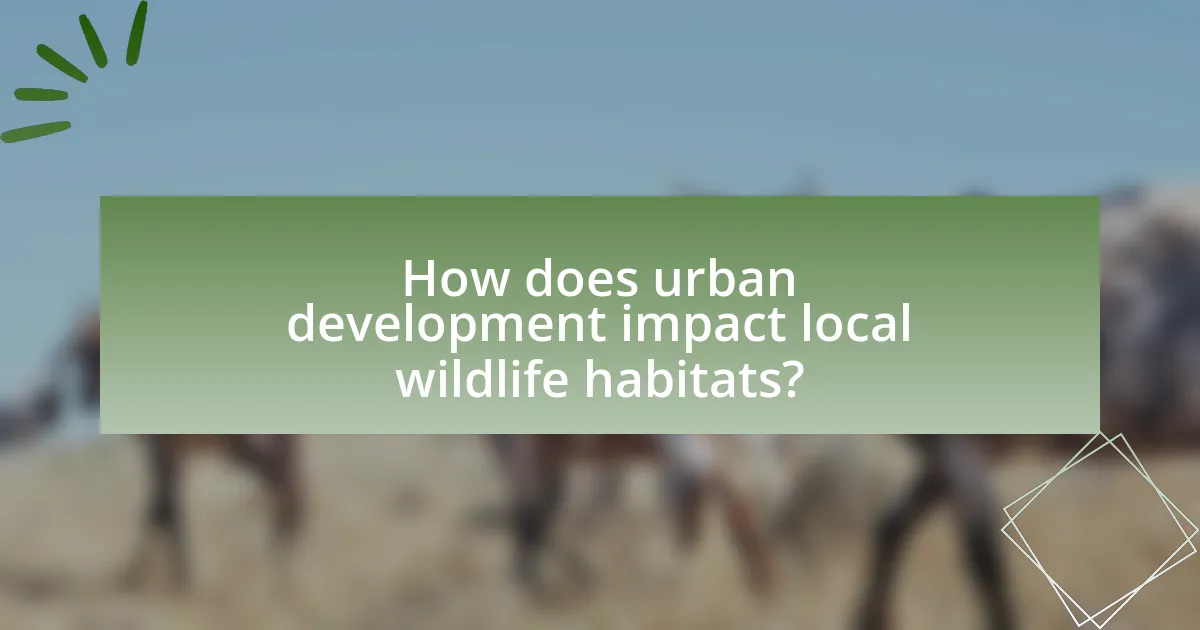
How does urban development impact local wildlife habitats?
Urban development significantly impacts local wildlife habitats by fragmenting ecosystems, reducing biodiversity, and altering natural landscapes. As cities expand, natural habitats are often destroyed or modified, leading to a loss of shelter and food sources for various species. For instance, a study published in the journal “Ecological Applications” found that urbanization can decrease species richness by up to 75% in affected areas. Additionally, the introduction of artificial structures and pollutants can further disrupt wildlife behavior and health, making it challenging for many species to survive in urbanized environments.
What are the primary ways urban development affects wildlife?
Urban development primarily affects wildlife through habitat loss, fragmentation, and pollution. Habitat loss occurs when natural areas are converted into urban spaces, reducing the available land for wildlife. For instance, studies indicate that urbanization has led to a significant decline in biodiversity, with some species facing extinction due to the destruction of their habitats. Fragmentation occurs when large habitats are divided into smaller, isolated patches, making it difficult for wildlife to migrate, find food, and reproduce. Research shows that fragmented landscapes can lead to decreased genetic diversity among animal populations. Pollution from urban areas, including light, noise, and chemical contaminants, further disrupts wildlife behavior and health, as many species are sensitive to these changes. For example, urban runoff can contaminate water sources, affecting aquatic life.
How does habitat fragmentation occur due to urbanization?
Habitat fragmentation occurs due to urbanization when natural landscapes are divided into smaller, isolated patches as cities expand. This process is driven by the construction of roads, buildings, and other infrastructure, which disrupts the continuity of ecosystems. For instance, a study published in the journal “Ecological Applications” found that urban development can reduce habitat connectivity by up to 70%, severely impacting wildlife movement and biodiversity. As a result, species may become isolated, leading to decreased genetic diversity and increased vulnerability to extinction.
What role does pollution play in altering wildlife habitats?
Pollution significantly alters wildlife habitats by degrading air, water, and soil quality, which directly impacts the health and survival of various species. For instance, chemical pollutants such as heavy metals and pesticides can contaminate water sources, leading to toxic environments that harm aquatic life and disrupt food chains. Additionally, air pollution can affect plant growth, reducing the availability of food and shelter for herbivores and, consequently, the predators that rely on them. Studies have shown that urban areas with high pollution levels experience a decline in biodiversity, as sensitive species are unable to adapt to the altered conditions. This evidence underscores the critical role pollution plays in transforming wildlife habitats and threatening ecosystem stability.
Why is it important to understand the effects of urban development on wildlife?
Understanding the effects of urban development on wildlife is crucial because it directly impacts biodiversity and ecosystem health. Urbanization leads to habitat loss, fragmentation, and pollution, which can threaten species survival and disrupt ecological balance. For instance, a study published in the journal “Ecological Applications” found that urban areas can reduce species richness by up to 75% compared to natural habitats. This understanding allows for informed planning and conservation efforts to mitigate negative impacts, ensuring that urban growth does not come at the expense of wildlife populations and their habitats.
How does urban development threaten biodiversity?
Urban development threatens biodiversity primarily through habitat destruction, fragmentation, and pollution. As cities expand, natural habitats are often cleared for construction, leading to the loss of ecosystems that support various species. For instance, a study by the World Wildlife Fund indicates that urbanization has contributed to the decline of over 50% of species in some regions due to habitat loss. Additionally, urban areas create barriers that fragment habitats, making it difficult for species to migrate, find food, and reproduce. Pollution from urban runoff and emissions further degrades the quality of remaining habitats, adversely affecting the health of wildlife populations.
What are the long-term consequences for ecosystems?
Long-term consequences for ecosystems due to urban development include habitat fragmentation, loss of biodiversity, and altered ecosystem services. Habitat fragmentation occurs when urban areas divide natural habitats into smaller, isolated patches, making it difficult for species to migrate, find mates, or access resources. This fragmentation can lead to a decline in species populations and increased extinction rates, as evidenced by studies showing that urbanization can reduce species richness by up to 50% in affected areas. Loss of biodiversity results from the conversion of natural landscapes into urban environments, which diminishes the variety of species and genetic diversity essential for ecosystem resilience. Additionally, altered ecosystem services, such as water filtration, carbon storage, and pollination, can occur as urban development disrupts natural processes, leading to increased flooding, air pollution, and reduced agricultural productivity. These consequences highlight the significant and lasting impact of urban development on ecosystems.
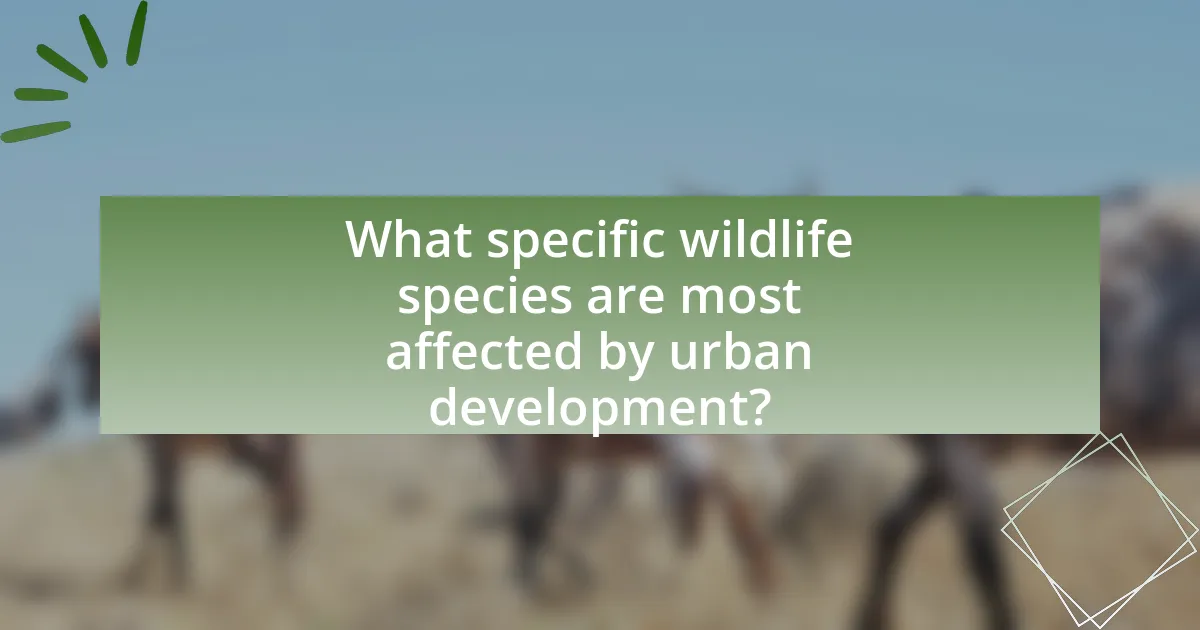
What specific wildlife species are most affected by urban development?
Urban development most significantly affects species such as the Eastern Box Turtle, American Robin, and Red Fox. These species experience habitat loss due to land conversion for residential and commercial use, which disrupts their natural environments. For instance, the Eastern Box Turtle’s population has declined by over 50% in some areas due to urban sprawl, as their habitats are fragmented and reduced. Similarly, American Robins face challenges in nesting and foraging as urban landscapes replace natural vegetation. Red Foxes, while adaptable, often struggle with increased human activity and vehicle traffic, leading to higher mortality rates. These examples illustrate the direct impact of urban development on specific wildlife species, highlighting the urgent need for conservation efforts in urban planning.
How do different species respond to urban environments?
Different species respond to urban environments in varied ways, often influenced by their adaptability and ecological needs. For instance, some species, like raccoons and pigeons, thrive in urban settings due to their opportunistic feeding habits and ability to exploit human resources. Conversely, species such as amphibians and certain birds may decline in urban areas due to habitat loss, pollution, and increased predation. Research indicates that urbanization can lead to a decrease in biodiversity, with studies showing that urban areas can support only a fraction of the species found in natural habitats. For example, a study published in “Ecological Applications” by McKinney (2002) highlights that urbanization often results in habitat fragmentation, which negatively impacts species that require larger territories or specific habitat types.
What adaptations do urban wildlife exhibit?
Urban wildlife exhibit several adaptations to thrive in urban environments, including behavioral changes, dietary flexibility, and altered reproductive strategies. For instance, species like raccoons and pigeons have adapted to scavenging human food sources, demonstrating dietary flexibility that allows them to exploit urban resources. Additionally, many urban wildlife species exhibit altered reproductive strategies, such as increased litter sizes or earlier breeding seasons, to maximize their chances of survival in fragmented habitats. These adaptations are essential for their survival in increasingly urbanized landscapes, where natural habitats are often diminished.
Which species are at the highest risk of decline?
Amphibians, particularly species like the California red-legged frog and the Eastern tiger salamander, are at the highest risk of decline due to urban development. Urbanization leads to habitat loss, fragmentation, and pollution, which severely impact these amphibians’ breeding and survival. According to the IUCN Red List, over 40% of amphibian species are experiencing population declines, primarily driven by habitat destruction linked to urban expansion.
What are the implications for local food webs?
Urban development significantly disrupts local food webs by altering habitats and reducing biodiversity. This disruption can lead to a decline in native species, as their natural habitats are replaced with urban infrastructure, which diminishes available resources such as food and shelter. For instance, studies have shown that urbanization can result in a 50% reduction in species richness in affected areas, leading to imbalanced food webs where certain species may dominate while others decline or disappear. Consequently, this imbalance can affect ecosystem functions, such as pollination and nutrient cycling, which are vital for maintaining healthy environments.
How does the loss of species affect predator-prey relationships?
The loss of species disrupts predator-prey relationships by altering population dynamics and food availability. When a species is lost, predators may face a decline in their primary food sources, leading to starvation or decreased reproductive success. For example, the decline of herbivores due to habitat destruction can result in reduced food for carnivores, ultimately destabilizing the ecosystem. Research indicates that biodiversity loss can lead to increased competition among remaining species, further complicating predator-prey interactions and potentially leading to ecosystem collapse.
What happens to plant species in urbanized areas?
Plant species in urbanized areas often experience habitat loss, fragmentation, and altered environmental conditions. Urban development leads to the replacement of natural landscapes with buildings and infrastructure, which reduces the available space for native plants to thrive. Studies indicate that urbanization can decrease plant diversity by up to 50% in some regions, as native species struggle to compete with invasive species that often flourish in disturbed environments. Additionally, changes in soil composition, increased pollution, and altered water drainage patterns further stress plant communities, making it difficult for them to survive and reproduce.

What strategies can mitigate the impact of urban development on wildlife habitats?
Strategies to mitigate the impact of urban development on wildlife habitats include creating wildlife corridors, implementing green infrastructure, and enforcing zoning regulations that protect natural areas. Wildlife corridors, such as overpasses and underpasses, facilitate animal movement between fragmented habitats, reducing roadkill and promoting genetic diversity. Green infrastructure, including parks, green roofs, and urban forests, enhances biodiversity and provides essential ecosystem services. Zoning regulations can limit development in critical habitats, ensuring that essential wildlife areas remain intact. Studies show that cities incorporating these strategies experience less biodiversity loss and improved ecological resilience, demonstrating their effectiveness in preserving wildlife habitats amidst urbanization.
How can urban planning incorporate wildlife conservation?
Urban planning can incorporate wildlife conservation by integrating green spaces, wildlife corridors, and sustainable land-use practices into urban designs. These elements facilitate the movement and habitat of various species, thereby reducing habitat fragmentation. For instance, cities like Singapore have successfully implemented vertical gardens and green roofs, which not only enhance biodiversity but also improve air quality and reduce urban heat. Research indicates that urban areas with accessible green spaces can support a higher diversity of wildlife, as seen in studies conducted by the University of California, which found that urban parks can serve as critical habitats for birds and insects.
What are the benefits of creating green spaces in urban areas?
Creating green spaces in urban areas enhances biodiversity, improves air quality, and promotes mental well-being. These spaces serve as habitats for various species, contributing to the preservation of local wildlife. Research indicates that urban green areas can increase species richness by up to 30%, providing essential resources for birds, insects, and other wildlife. Additionally, green spaces help filter pollutants, reducing urban air pollution by approximately 30%, which benefits both human health and the environment. Furthermore, studies show that access to green spaces can reduce stress and anxiety levels in urban populations, leading to improved mental health outcomes.
How can wildlife corridors be effectively implemented?
Wildlife corridors can be effectively implemented by strategically designing and establishing pathways that connect fragmented habitats, allowing for safe animal movement. This involves conducting thorough ecological assessments to identify critical areas for connectivity, such as migration routes and breeding grounds. Research indicates that well-planned corridors can significantly reduce wildlife mortality rates and enhance genetic diversity, as demonstrated in studies like the one published in “Ecological Applications” by Beier and Noss, which highlights the importance of connectivity in maintaining healthy ecosystems. Additionally, collaboration with urban planners, landowners, and conservation organizations is essential to secure land and resources for these corridors, ensuring they are integrated into urban development plans.
What role do community initiatives play in protecting wildlife?
Community initiatives play a crucial role in protecting wildlife by fostering local engagement and awareness about conservation efforts. These initiatives often involve local residents in habitat restoration projects, wildlife monitoring, and educational programs that highlight the importance of biodiversity. For instance, community-led conservation efforts have been shown to increase local stewardship, leading to improved habitat conditions and reduced human-wildlife conflict. Research indicates that areas with active community involvement in conservation see a 30% increase in species diversity compared to those without such initiatives, demonstrating their effectiveness in enhancing wildlife protection.
How can local residents contribute to wildlife conservation efforts?
Local residents can contribute to wildlife conservation efforts by participating in community-based conservation programs and advocating for sustainable urban planning. Engaging in local initiatives, such as habitat restoration projects or wildlife monitoring, allows residents to directly impact their environment. For instance, studies show that community involvement in conservation can lead to a 30% increase in local biodiversity, as seen in urban areas where residents actively participate in green space management. Additionally, advocating for policies that protect natural habitats during urban development can help mitigate the negative effects of urbanization on wildlife.
What are some successful case studies of urban wildlife protection?
Successful case studies of urban wildlife protection include the creation of the High Line in New York City, which transformed an abandoned elevated railway into a green space that supports various bird species and native plants. This project not only preserved urban wildlife habitats but also increased biodiversity in a densely populated area. Another example is the rewilding efforts in the city of San Francisco, where the implementation of green roofs and urban gardens has led to the resurgence of pollinators and other wildlife, demonstrating effective habitat restoration in urban settings. Additionally, the establishment of wildlife corridors in cities like Los Angeles has facilitated safe passage for species such as coyotes and bobcats, allowing them to thrive despite urban encroachment. These case studies illustrate successful strategies for integrating wildlife protection into urban development.
What practical steps can individuals take to support local wildlife?
Individuals can support local wildlife by creating habitats, such as planting native plants and maintaining gardens that provide food and shelter. Native plants attract local pollinators and birds, which are essential for ecosystem balance. Additionally, individuals can reduce pesticide use, as chemicals can harm beneficial insects and other wildlife. Providing water sources, like bird baths or small ponds, can also help sustain local species. Furthermore, individuals can participate in local conservation efforts, such as clean-up events or habitat restoration projects, which directly benefit wildlife populations. Engaging in these activities contributes to biodiversity and helps mitigate the negative impacts of urban development on local wildlife habitats.

